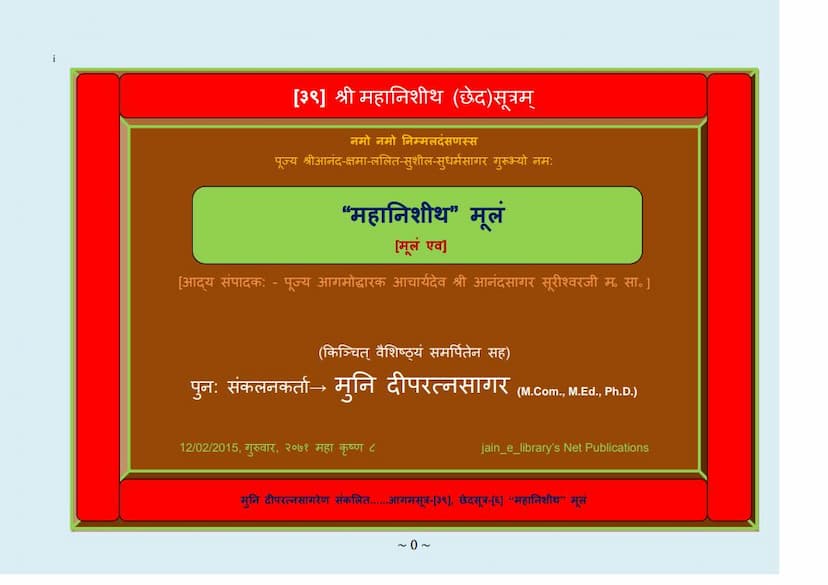Aagam 39 MAHA NISHITH Moolam Ev
Added to library: September 1, 2025

Summary
This Jain text, titled "Aagam 39 MAHA NISHITH Moolam ev" (or "Shri Maha Nishith (Chhed) Sutra"), is a foundational text within the Jain Agamas, specifically categorized as a Chhed Sutra. This particular publication is a compilation and re-presentation of the original text, undertaken by Muni Dippratnasagar, with the foundational editing and revision by Acharya Shri Anand Sagar Surishwarji.
Here's a breakdown of the key aspects presented in the provided pages:
1. Title and Authorship:
- Title: Shri Maha Nishith (Chhed) Sutra (श्री महानिशीथ (छेद)सूत्रम्)
- Author/Compiler: Muni Dippratnasagar (मुनि दीपरत्नसागर)
- Original Editor/Reviser: Acharya Shri Anand Sagar Surishwarji (आचार्यदेव श्री आनंदसागर सूरीश्वरजी म. सा.)
- Publisher: Deepratnasagar (Deepratnasagar)
2. Nature of the Text:
- "Moolam ev" (मूलं एव): This indicates the text is presented in its original, fundamental form, without extensive commentary.
- "Chhed Sutra" (छेदसूत्र): In Jain tradition, Chhed Sutras are considered highly important and deal with specific aspects of monastic conduct, discipline, and purification. The Maha Nishith Sutra is one of the six core Chhed Sutras.
3. Significance and Context:
- "Aagam 39": This signifies its position within the Jain canon, where the Maha Nishith is considered the 39th Agama (or more specifically, the 6th Chhed Sutra).
- Historical Context: The text notes that the original compilation by Acharya Shri Anand Sagar Surishwarji was part of a larger work called "Agam Manjusha" in 1942, which included 45 Agamas, supplementary texts, and five Niryuktis. This work was also inscribed on stone at Shatrunjay Tirth and on copper plates in Surat. This current publication is a digital re-presentation (photo-scanned) of that 6+1 Chhed Sutra portion.
- Purpose of This Edition: Muni Dippratnasagar explains that this effort is driven by the respect and devotion people have for Acharya Shri Sagaranand Surishwarji (Anand Sagar Surishwarji) and to ensure the 6 Agamas (Chhed Sutras) are not overlooked when referring to the 39 Agamas. The aim is to provide easy access to these important texts through the internet and potentially future print editions.
4. Content Structure:
- Table of Contents (विषयानक्रम - Page 3): The provided table of contents indicates the structure of the Maha Nishith Sutra, which is divided into several "Adhyayans" (Studies) and within those, "Uddeshaks" (Sections/Topics). The listed Adhyayans are:
- Adhyayan Pratham (Study One)
- Adhyayan Dwitiya (Study Two)
- Adhyayan Tritiya (Study Three)
- Adhyayan Chaturth (Study Four)
- Adhyayan Pancham (Study Five) - Includes "Sushad Angar Katha" (चूलिका-2)
- Adhyayan Shashth (Study Six) - Includes "Ekant Nirjara Chulika-1" (चूलिका-1)
- Page Layout: The publication is designed for clarity, with the Agama's name, Adhyayan, Uddeshak, and the original scripture's verse/Gatha number clearly indicated on each page. Special formatting is used to distinguish between "Sutra" (सूत्र) and "Gatha" (गाथा).
5. Editorial Features:
- "Deep Anukram" (दीप-अनुक्रमा): A unique sequential numbering system used by the publisher, likely to cross-reference across their various publications.
- Footnotes: Some pages have specific footnotes providing additional information, clarifying printing errors, or sequence mistakes in the original text.
- Language: The text is in Prakrit (the language of many Jain Agamas), with some explanations or contextual information possibly in Hindi or other contemporary languages based on the editorial notes.
6. Content Samples (Pages 5 onwards): The subsequent pages show excerpts of the Maha Nishith Sutra itself, in Prakrit. These are dense, philosophical, and regulatory texts dealing with various aspects of Jain monasticism. The content includes:
- Discussions on renunciation, detachment, karma, virtue, and the path to liberation.
- Detailed guidelines on conduct, ethical behavior, and the consequences of actions.
- Instructions for ascetics (munis) regarding their daily life, practices, and spiritual development.
- Emphasis on introspection, repentance, and the purification of the soul.
- The text delves into complex philosophical concepts and ethical dilemmas faced by ascetics.
In essence, this publication is a faithful digital reproduction of a significant Jain Chhed Sutra, presented in its original form and made accessible through modern technology, honoring the legacy of previous acharyas and aiming to disseminate this profound spiritual knowledge.